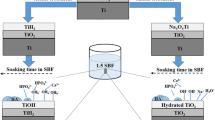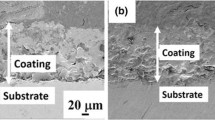Abstract
In this study, Ti6Al4V plates were gone through three steps of pretreatment process (sandblasting + acid etching + preheating) followed by biomimetic coating of pure hydroxyapatites (HAp) on pretreated substrate. Pretreated substrates were examined by SEM, EDS, AFM, FTIR, and XRD; meanwhile, prepared coatings were examined by SEM, EDS, FTIR, XRD, XPS, scratch test, and in vitro cell studies (SaOS-2 cell line). Prepared coatings were also investigated in terms of antibacterial property by determining the survival of the Staphylococcus epidermidis on the surface. Structural analysis results of pretreated substrates proved that surface roughness increased proportionally as sandblasting, acid etching, and preheating process were performed. Successively, surface became more porous according to SEM images which were also supported by AFM results that indicate that Ra increased up to 953 nm values. EDS and FTIR spectra showed that functional groups were formed with the pretreatment procedure. Especially titanium salts were formed during acid etching process while preheating caused oxidation. XRD spectra revealed that as-received substrates mostly consisted of α-Ti, acid etching resulted in formation of TiH2 structure and oxidation resulted to form rutile and anatase structure patterns. Pretreatment procedure had positive effect on biomimetic coatings according to the evaluation of structural, mechanical, and biological properties. SEM analysis revealed that HAp nucleation started 4 days after immersion and nucleation increased with the incubation time. EDS results indicated that maximum Ca/P ratio (1.48) was achieved by P14. FTIR, XRD, and XPS analysis proved the presence of hydroxyapatite on the substrate surface. The pretreatment procedure had significant influence on mechanical properties of the coatings resulting in increase of critical loads. P14 sample had the highest critical load. In terms of biological evaluation, P14 exhibited the highest cell proliferation and lowest bacterial adhesion. The highest stability and coherence of P14 coating was also confirmed by mechanical test results. Eventually, it was observed that pretreatment technique has great effect on surface properties. In addition, 14 days immersion period was found to be optimum along the investigated immersion times.











Similar content being viewed by others
References
Chen, W., Liu, Y., Courtney, H.S., Bettenga, M., Agrawal, C.M., Bumgardner, J.D., Ong, J.L.: In vitro anti-bacterial and biological properties of magnetron co-sputtered silver-containing hydroxyapatite coating. Biomater. 27, 5512–5517 (2006)
Dobzyniak, M., Fehring, T.K., Odum, S.: Early failure in total hip arthroplasty. Clin. Orthop. Relat. Res. 447, 76–78 (2006)
Losina, E., Barrett, J., Mahomed, N.N., Baron, J.A., Katz, J.N.: Early failures of total hip replacement: effect of surgeon volume. Arthritis Rheum. 50, 1338–1343 (2004)
Long, M., Rack, H.J.: Titanium alloys in total joint replacement-a materials science perspective. Biomater. 19, 1621–1639 (1998)
Xu, S., Xiaoyu, Y., Yuan, S., Minhua, T., Jian, L., Aidi, N., Xing, L.: Morphology improvement of sandblasted and acid-etched titanium surface and osteoblast attachment promotion by hydroxyapatite coating. Rare Metal Mater. Eng. 44, 67–72 (2015)
Fujibayashi, S., Neo, M., Kim, H.M., Kokubo, T., Nakamura, T.: Osteoinduction of porous bioactive titanium metal. Biomater. 25, 443–450 (2004)
Kokubo, T., Yamaguchi, S.: Novel bioactive materials developed by simulated body fluid evaluation: surface-modified Ti metal and its alloys. Acta Biomater. 44, 16–30 (2016)
Liu, X., Chu, P.K., Ding, C.: Surface modification of titanium, titanium alloys, and related materials for biomedical applications. Mater. Sci. Eng. R. Rep. 47, 49–121 (2004)
Liu, Y., Jiang, T., Zhou, Y., Zhang, Z., Wang, Z., Tong, H., Shen, X., Wang, Y.: Evaluation of the attachment, proliferation, and differentiation of osteoblast on a calcium carbonate coating on titanium surface. Mater. Sci. Eng. C. 31, 1055–1061 (2011)
Yanovska, A., Kuznetsov, V., Stanislavov, A., Danilchenko, S., Sukhodub, L.: Synthesis and characterization of hydroxyapatite-based coatings for medical implants obtained on chemically modified Ti6Al4V substrates. Surf. Coat. Technol. 205, 5324–5329 (2011)
An, S.H., Matsumoto, T., Miyajima, H., Sasaki, J.I., Narayanan, R., Kim, K.H.: Surface characterization of alkali- and heat-treated Ti with or without prior acid etching. Appl. Surf. Sci. 258, 4377–4382 (2012)
Chen, J.C., Ko, C.L., Lin, D.J., Wu, H.Y., Hung, C.C., Chen, W.C.: In vivo studies of titanium implant surface treatment by sandblasted, acid-etched and further anchored with ceramic of tetracalcium phosphate on osseointegration. J. Aust. Ceram. Soc. (2019). https://doi.org/10.1007/s41779-018-00292-5
Deng, F., Zhang, W., Zhang, P., Liu, C., Ling, J.: Improvement in the morphology of micro-arc oxidised titanium surfaces: a new process to increase osteoblast response. Mater. Sci. Eng. C. 30, 141–147 (2010)
Ban, S., Iwaya, Y., Kono, H., Sato, H.: Surface modification of titanium by etching in concentrated sulfuric acid. Dent. Mater. 22, 1115–1120 (2006)
Turk, S., Altınsoy, I., Çelebi, G.E., Ipek, M., Ozacar, M., Bindal, C.: A comparison of pretreatments on hydroxyapatite formation on Ti by biomimetic method. J. Aust. Ceram. Soc. 54, 533–543 (2018)
Kokubo, T., Takadama, H.: How useful is SBF in predicting in vivo bone bioactivity? Biomater. 27, 2907–2915 (2006)
Ohtsu, N., Kakuchi, Y., Ohtsuki, T.: Antibacterial effect of zinc oxide/hydroxyapatite coatings prepared by chemical solution deposition. Appl. Surf. Sci. 445, 596–600 (2017)
Yang, A., Han, Y., Pan, Y., Xing, H., Li, J.: Optimum surface roughness prediction for titanium alloy by adopting response surface methodology. Results Phys. 7, 1046–1050 (2017)
Henriques, B., Sampaio, M., Buciumeanu, M., Souza, J.C.M., Gomes, J.R., Silva, F., Carvalho, O.: Laser surface structuring of Ti6Al4V substrates for adhesion enhancement in Ti6Al4V-PEEK joints. Mater. Sci. Eng. C. 79, 177–184 (2017)
Baek, S.M., Polyakov, A.V., Moon, J.H., Semenova, I.P., Valiev, R.Z., Kim, H.S.: Effect of surface etching on the tensile behavior of coarse- and ultrafine-grained pure titanium. Mater. Sci. Eng. A. 707, 337–343 (2017)
Hatamleh, M.M., Wu, X., Alnazzawi, A., Watson, J., Watts, D.: Surface characteristics and biocompatibility of cranioplasty titanium implants following different surface treatments. Dent. Mater. 34, 676–683 (2018)
Li, B., Li, J., Liang, C., Li, H., Guo, L., Liu, S., Wang, H.: Surface roughness and hydrophilicity of titanium after anodic oxidation. Rare Metal Mater. Eng. 45, 858–862 (2016)
Shokri, B., Firouzjah, M.A., Hosseini, S.I.: FTIR analysis of silicon dioxide thin film deposited by metal organic-based PECVD. Proc. 19th Int. Plasma Chem Soc, pp. 1–4 (2009)
Givan, A., Grothe, H., Loewenschuss, A., Nielsen, C.J.: Infrared spectra and ab initio calculations of matrix isolated dimethyl sulfone and its water complex. Phys. Chem. Chem. Phys. 4, 255–263 (2002)
Hamadanian, M., Reisi-Vanani, A., Majedi, A.: Sol-gel preparation and characterization of co/TiO2 nanoparticles: application to the degradation of methyl orange. J. Iran. Chem. Soc. 7, 52–58 (2010)
Infrared Spectroscopy Absorption Table-Chemistry LibreTexts. https://chem.libretexts.org/Reference/Reference_Tables/Spectroscopic_Parameters/Infrared_Spectroscopy_Absorption_Table. Accessed 17 March 2018
Yilmaz, B., Evis, Z., Güldiken, M.: Titanyum Alaşımının Biyomimetik Yöntemle Kalsiyum Fosfat Kaplanması. J. Fac. Eng. Archit. Gazi Univ. 29, 105–109 (2014)
Teker, D., Muhaffel, F., Menekse, M., Karaguler, N.G., Baydogan, M., Cimenoglu, H.: Characteristics of multi-layer coating formed on commercially pure titanium for biomedical applications. Mater. Sci. Eng. C. 48, 579–585 (2015)
Liu, D.M., Troczynski, T., Tseng, W.J.: Water-based sol-gel synthesis of hydroxyapatite: process development. Biomater. 22, 1721–1730 (2001)
Avci, M., Yilmaz, B., Tezcaner, A., Evis, Z.: Strontium doped hydroxyapatite biomimetic coatings on Ti6Al4V plates. Ceram. Int. 43, 9431–9436 (2017)
Silva, C.C., Pinheiro, A.G., Miranda, M.A.R., Góes, J.C., Sombra, A.S.B.: Structural properties of hydroxyapatite obtained by mechanosynthesis. Solid State Sci. 5, 553–558 (2003)
Pylypchuk, I.V., Gorbyk, P.P., Petranovska, A.L., Korduban, O.M., Markovsky, P.E., Ivasyshyn, O.M.: Chapter 7 - Formation of Biomimetic Hydroxyapatite Coatings on the Surface of Titanium and Ti-Containing Alloys: Ti-6Al-4V and Ti-Zr-Nb. Appl. Nanobiomater. 3, 193–229 (2016)
Durdu, S., Usta, M., Berkem, A.S.: Bioactive coatings on Ti6Al4V alloy formed by plasma electrolytic oxidation. Surf. Coat. Technol. 301, 85–93 (2016)
Al-Hazmi, F.E.: Synthesis and electrical properties of Bi doped hydroxyapatite ceramics. J. Alloys Compd. 665, 119–123 (2016)
Wang, H.Y., Zhu, R.F., Lu, Y.P., Xiao, G.Y., He, K., Yuan, Y.F., Ma, X.N., Li, Y.: Effect of sandblasting intensity on microstructures and properties of pure titanium micro-arc oxidation coatings in an optimized composite technique. Appl. Surf. Sci. 292, 204–212 (2014)
Sumathi, S., Buvaneswari, G.: Synthesis of apatite structure based BiNaCa3(PO4)3OH and its application for condensation reaction. Ceram. Int. 38, 3547–3552 (2012)
Cochis, A., Azzimonti, B., Valle, C.D., De Giglio, E., Bloise, N., Visai, L., Cometa, S., Rimondini, L., Chiesa, R.: The effect of silver or gallium doped titanium against the multidrug resistant Acinetobacter baumannii. Biomater. 80, 80–95 (2016)
Forsgren, J., Svahn, F., Jarmar, T., Engqvist, H.: Formation and adhesion of biomimetic hydroxyapatite deposited on titanium substrates. Acta Biomater. 3, 980–984 (2007)
Yilmaz, B., Evis, Z., Tezcaner, A., Banerjee, S.: Surface characterization and biocompatibility of selenium-doped hydroxyapatite coating on titanium alloy. Int. J. Appl. Ceram. Technol. 13, 1059–1068 (2016)
Andrukhov, O., Huber, R., Shi, B., Berner, S., Rausch-Fan, X., Moritz, A., Spencer, N.D., Schedle, A.: Proliferation, behavior, and differentiation of osteoblasts on surfaces of different microroughness. Dent. Mater. 32, 1374–1384 (2016)
Rupp, F., Liang, L., Geis-Gerstorfer, J., Scheideler, L., Hüttig, F.: Surface characteristics of dental implants: a review. Dent. Mater. 34, 40–57 (2018)
Yilmaz, B., Alshemary, A.Z., Evis, Z.: Co-doped hydroxyapatites as potential materials for biomedical applications. Microchem. J. 144, 443–453 (2019)
Author information
Authors and Affiliations
Corresponding author
Additional information
Publisher’s note
Springer Nature remains neutral with regard to jurisdictional claims in published maps and institutional affiliations.
Available Online at: www.austceram.com/ACS-Journal
Rights and permissions
About this article
Cite this article
Hacioglu, T., Evis, Z., Tezcaner, A. et al. Effects of surface pretreatments and coating period on hydroxyapatite coating of Ti6Al4V alloy. J Aust Ceram Soc 56, 545–557 (2020). https://doi.org/10.1007/s41779-019-00364-0
Received:
Revised:
Accepted:
Published:
Issue Date:
DOI: https://doi.org/10.1007/s41779-019-00364-0




